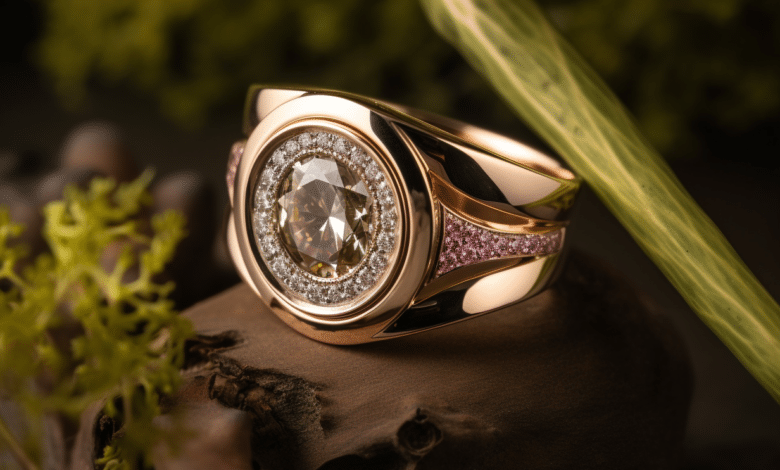Eco-Friendly Revolution: Sustainable Materials in Ring Design

In today’s world, where sustainability has become a crucial concern, the jewelry industry is undergoing a remarkable transformation. As consumers become more conscious of their environmental impact, they are seeking ethical and eco-friendly alternatives to traditional materials. In response, innovative designers and jewelers are embracing sustainable materials, ushering in a new era of responsible luxury. This article delves into the fascinating world of sustainable ring design, exploring the hidden features, innovative techniques, and secret compartments that make these pieces truly unique and environmentally conscious.
1. Features of Choosing Eco-Friendly Ring Materials
The traditional jewelry industry has long relied on precious metals and gemstones, but these resources come at a significant environmental cost. Mining operations can lead to habitat destruction, pollution, and unethical labor practices. However, the rise of sustainable materials offers a compelling alternative that not only reduces the ecological footprint but also introduces unique qualities and design possibilities.
- Recycled Metals: Jewelers are increasingly turning to recycled precious metals, such as gold, silver, and platinum, to minimize the need for new mining. These materials are reclaimed from various sources, including scrap jewelry, electronics, and industrial waste, reducing the demand for virgin materials and preserving natural resources.
- Lab-Grown Diamonds: While natural diamonds have a captivating allure, their mining process can be environmentally destructive and socially problematic. Lab-grown diamonds, created through advanced technology, offer an ethical and sustainable alternative that is chemically and optically identical to their mined counterparts, without the environmental toll.
- Ethical Gemstones: Responsible jewelers are sourcing gemstones from ethical and traceable sources, ensuring that the stones are conflict-free and mined using responsible practices. Some jewelers even partner with mining communities to support local economies and promote sustainable practices.
2. Innovative Jewelry Design with Sustainable Materials
The adoption of sustainable materials has not only addressed environmental concerns but has also opened up new realms of creative expression for jewelry designers. By embracing these innovative materials, designers are pushing the boundaries of traditional ring design, incorporating unique features and secret compartments that captivate and delight.
- Seed-Embedding: Some jewelers are incorporating seeds into their designs, creating rings that can be planted and grow into vibrant plants or flowers once their lifespan as jewelry has ended. This innovative technique not only adds a touch of whimsy but also promotes sustainability by allowing the ring to give back to nature.
- Secret Compartments: Sustainable materials like recycled wood and plant-based resins offer unique opportunities for concealed compartments within rings. These hidden spaces can hold personal mementos, messages, or even tiny plant seeds, creating a delightful surprise and adding a layer of storytelling to the design.
- Modular Designs: Sustainable rings can be designed to be modular, with interchangeable components that allow the wearer to customize and adapt the piece to their personal style or occasion. This not only extends the lifespan of the ring but also reduces waste by eliminating the need for multiple separate pieces.
3. The Impact of Sustainable Rings on the Industry
The rise of sustainable ring design is more than just a trend; it represents a paradigm shift in the jewelry industry. As consumers become more conscious of their environmental impact, they are actively seeking out brands and designers that align with their values. This shift has driven many established jewelers to adapt their practices and embrace sustainable materials, while also fostering the growth of new eco-conscious brands.
- Consumer Awareness: Social media and influencer marketing have played a significant role in raising consumer awareness about the environmental and ethical implications of traditional jewelry production. Consumers are now more informed and actively seek out sustainable options, driving demand for responsible and transparent practices.
- Industry Collaboration: To address the challenges of sustainable sourcing and production, jewelers are forming partnerships and collaborations with organizations, communities, and other industry players. These collaborations foster knowledge-sharing, promote ethical practices, and drive innovation in sustainable materials and techniques.
- Storytelling and Transparency: Sustainable ring designers recognize the importance of storytelling and transparency in connecting with conscious consumers. They showcase the origins of their materials, highlight their ethical practices, and share the stories behind their unique designs, fostering a deeper emotional connection with their customers.
The eco-friendly revolution in ring design represents a profound shift towards responsible luxury and a more sustainable future for the jewelry industry. As consumers become increasingly conscious of their environmental impact, the demand for sustainable materials and innovative designs will continue to grow. By embracing these changes, jewelers and designers are not only meeting the needs of conscious consumers but also paving the way for a more ethical and environmentally responsible industry. The hidden features, secret compartments, and unique elements of sustainable rings offer a glimpse into a future where luxury and sustainability can coexist, allowing us to appreciate the beauty of jewelry while preserving the beauty of our planet.








